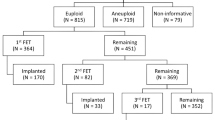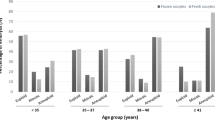Abstract
Purpose
To understand the clinical factors associated with embryo survival after vitrification in a cohort of human blastocysts screened by preimplantation genetic testing for aneuploidy (PGT-A).
Methods
Patient demographic, embryo, and cycle characteristics associated with failed euploid blastocyst survival were compared in a cohort of women (n = 6167) who underwent IVF-PGT-A.
Results
Compared to those that survived warming, vitrified euploid embryos that failed to survive after warming came from IVF cycles with significantly higher estradiol levels at time of surge (2754.8 ± 1390.2 vs. 2523.1 ± 1190.6 pg/mL, p = 0.03), number of oocytes retrieved (19.6 ± 10.7 vs. 17.5 ± 9.8, p = 0.005), and basal antral follicle count (BAFC) (15.3 ± 8.5 vs. 13.9 ± 7.2, p = 0.05). Euploid embryos were less likely to survive warming if they came from cycles before 2015 (24.6% vs. 13.2%, p < 0.001), were cryopreserved on day 7 versus day 5 or 6 (9.1% vs. 3.0%, p < 0.001), underwent two trophectoderm biopsies (6.9% vs. 2.3%, p < 0.001), had a grade C inner cell mass (15.4% vs. 7.7%, p < 0.001), or were fully hatched (41.1% vs. 12.2%, p < 0.001). In the multivariate model, which controlled for relevant confounders, the association between decreased survival and increased BAFC, year of IVF cycle, double trophectoderm biopsy, and fully hatched blastocysts remained statistically significant.
Conclusion
Euploid embryos that are fully hatched at time of vitrification, come from patients with high ovarian reserve, or require repeat trophectoderm biopsy are less likely to survive vitrification-warming. Our results provide a framework for reproductive counseling and offer realistic expectations to patients about the number of embryos needed to achieve family building goals.

Similar content being viewed by others
Data availability
Data is available upon request.
Code availability
Not applicable.
References
Nagy ZP, Shapiro D, Ching-Chien C. Vitrification of the human embryo: a more efficient and safer in vitro fertilization treatment. Fertil Steril. 2020;113:241–7.
Strauss JF, Barbieri RL. Yen & Jaffe’s reproductive endocrinology: pathophysiology, and clinical management. 8th ed. Philadelphia: Elsevier; 2019.
Loutradi KE, Kolibianakis EM, Venetis CA, Papanikolaou EG, Pado G, Bontis I, et al. Cryopreservation of human embryos by vitrification or slow freezing: a systematic review and meta-analysis. Fertil Steril. 2008;90:186–93.
Rezazadeh Valojerdi M, Eftekhari-Yazdi P, Karimian L, Hassani F, Movaghar B. Vitrification versus slow freezing gives excellent survival, post warming embryo morphology and pregnancy outcomes for human cleaved embryos. J Assist Reprod Genet. 2009;26:347–54.
Kolibianakis EM, Venetis CA, Tarlatzis BC. Cryopreservation of human embryos by vitrification or slow freezing: which one is better? Curr Opin Obstet Gynecol. 2009;21:270–4.
AbdelHafez FF, Desai N, Abou-Setta AM, Falcone T, Goldfarb J. Slow freezing, vitrification and ultra-rapid freezing of human embryos: a systematic review and meta-analysis. Reprod Biomed Online. 2010;20:209–22.
Keskintepe L, Sher G, Machnicka A, Tortoriella D, Bayrak A, Fisch J, et al. Vitrification of human embryos subjected to blastomere biopsy for pre-implantation genetic screening produces higher survival and pregnancy rates than slow freezing. J Assist Reprod Genet. 2009;26:629–35.
Rienzi L, Gracia C, Maggiulli R, LaBarbera AR, Kaser DJ, Ubaldi FM, et al. Oocyte, embryo and blastocyst cryopreservation in ART: systematic review and meta-analysis comparing slow-freezing versus vitrification to produce evidence for the development of global guidance. Hum Reprod Update. 2017;23:139–55.
Li Z, Wang YA, Ledger W, Edgar DH, Sullivan EA. Clinical outcomes following cryopreservation of blastocysts by vitrification or slow freezing: a population-based cohort study. Hum Reprod. 2014;29:2794–801.
Medved R, Virant-Klun I, Meden-Vrtovec H, Tomazevic T. Outcome of frozen-thawed blastocysts derived from gonadotropin releasing hormone agonist or antagonist cycles. J Assist Reprod Genet. 2006;23:275–9.
Pal L, Kovacs P, Witt B, Jindal S, Santoro N, Barad D. Postthaw blastomere survival is predictive of the success of frozen-thawed embryo transfer cycles. Fertil Steril. 2004;82:821–6.
Surrey E, Keller J, Stevens J, Gustofson R, Minjarez D, Schoolcraft W. Freeze-all: enhanced outcomes with cryopreservation at the blastocyst stage versus pronuclear stage using slow-freeze techniques. Reprod Biomed Online. 2010;21:411–7.
Pavone ME, Innes J, Hirshfeld-Cytron J, Kazer R, Zhang J. Comparing thaw survival, implantation and live birth rates from cryopreserved zygotes, embryos and blastocysts. J Hum Reprod Sci. 2011;4:23–8.
El-Toukhy T, Wharf E, Walavalkar R, Singh A, Bolton V, Khalaf Y, et al. Delayed blastocyst development does not influence the outcome of frozen-thawed transfer cycles. BJOG. 2011;118:1551–6.
Han AR, Park CW, Lee HS, Yang KM, Song IO, Koong MK. Blastocyst transfer in frozen-thawed cycles. Clin Exp Reprod Med. 2012;39:114–7.
Cimadomo D, Capalbo A, Levi-Setti PE, Soscia D, Orlando G, Albani E, et al. Associations of blastocyst features, trophectoderm biopsy and other laboratory practice with post-warming behavior and implantation. Hum Reprod. 2018;33:1992–2001.
Rodriguez-Purata J, Lee J, Whitehouse M, Duke M, Grunfeld L, Sandler B, et al. Reproductive outcome is optimized by genomic embryo screening, vitrification, and subsequent transfer into a prepared synchronous endometrium. J Assist Reprod Genet. 2016;33:401–12.
Gardner DK, Stevens J, Sheehan CB, Schoolcraft W. Analysis of blastocyst morphology. In: Elder K, Jacques C, eds. Human preimplantation embryo selection. London: Informa Healthcare, 2007;79–87.
Treff NR, Tao X, Ferry KM, Su J, Taylor D, Scott RT Jr. Development and validation of an accurate quantitative real-time polymerase chain reaction-based assay for human blastocyst comprehensive chromosomal aneuploidy screening. Fertil Steril. 2012;97:819–24.
Fiorentino F, Biricik A, Bono S, Spizzichino L, Cotroneo E, Cottone G, et al. Development and validation of a next-generation sequencing-based protocol for 24-chromosome aneuploidy screening of embryos. Fertil Steril. 2014;101:1375–82.
Grunfeld L, Walker B, Bergh PA, Sandler B, Hofmann G, Navot D. High-resolution endovaginal ultrasonography of the endometrium: a noninvasive test for endometrial adequacy. Obstet Gynecol. 1991;78:200–4.
Qiao J, Feng HL. Extra- and intra-ovarian factors in polycystic ovary syndrome: impact on oocyte maturation and embryo developmental competence. Hum Reprod Update. 2011;17:17–33.
Hernandez-Nieto C, Lee JA, Alkon-Meadows T, Luna-Rojas M, Mukherjee T, Copperman AB, et al. Late follicular phase progesterone elevation during ovarian stimulation is not associated with decreased implantation of chromosomally screened embryos in thaw cycles. Hum Reprod. 2020;35:1889–99.
Hernandez-Nieto C, Lee JA, Slifkin R, Sandler B, Copperman AB, Flisser E. What is the reproductive potential of day 7 euploid embryos? Hum Reprod. 2019;34:1697–706.
Desai N, Goldberg J, Austin C, Falcone T. Are cleavage anomalies, multinucleation or specific cell cycle kinetics observed with time-lapse imaging predictive of embryo developmental capacity or ploidy? Fertil Steril. 2018;109:665–74.
Minasi MG, Colasante A, Riccio T, Ruberti A, Casciani V, Scarselli F, Spinella F, Fiorentino F, Varricchio MT, Greco E. Correlation between aneuploidy, standard morphology evaluation and morphokinetic development in 1730 biopsied blastocysts: a consecutive case series study. Hum Reprod. 2016;31:2245–54.
Taylor TH, Patrick JL, Gitlin SA, Michael Wilson J, Crain JL, Griffin DK. Outcomes of blastocysts biopsied and vitrified once versus those cryopreserved twice for euploid blastocyst transfer. Reprod Biomed Online. 2014;29:59–64.
Desai N, Ploskonka S, Goodman L, Attaran M, Goldberg JM, Austin C, et al. Delayed blastulation, multinucleation, and expansion grade are independently associated with live-birth rates in frozen blastocyst transfer cycles. Fertil Steril. 2016;106:1370–8.
Rodriguez-Purata J, Gingold J, Lee J, Whitehouse M, Slifkin R, Briton-Jones C, et al. Hatching status before embryo transfer is not correlated with implantation rate in chromosomally screened blastocysts. Hum Reprod. 2016;31:2458–70.
Aluko A, Vaughan DA, Modest AM, Penzias AS, Hacker MR, Thorton K, Sakas D. Multiple cryopreservation-warming cycles, coupled with blastocyst biopsy, negatively affect IVF outcomes. Reprod Biomed Online. 2021;42:572–8.
Author information
Authors and Affiliations
Contributions
MO, CB, DG, JAL, ABC, and LS contributed to the design and implementation of the research, the analysis of the results, and the writing of the manuscript.
Corresponding author
Ethics declarations
Ethics approval
This study was approved by the Icahn School of Medicine at Mount Sinai Institutional Review Board with a waiver of consent for retrospective analysis of de-identified data.
Conflict of interest
ABC is the Chief Medical Officer of Sema4 and Medical Director of Progyny. MO, CB, DG, JAL, and LS have no relevant financial or non-financial interests to disclose.
Additional information
Publisher's note
Springer Nature remains neutral with regard to jurisdictional claims in published maps and institutional affiliations.
Rights and permissions
About this article
Cite this article
Oliva, M., Briton-Jones, C., Gounko, D. et al. Factors associated with vitrification-warming survival in 6167 euploid blastocysts. J Assist Reprod Genet 38, 2671–2678 (2021). https://doi.org/10.1007/s10815-021-02284-0
Received:
Accepted:
Published:
Issue Date:
DOI: https://doi.org/10.1007/s10815-021-02284-0




